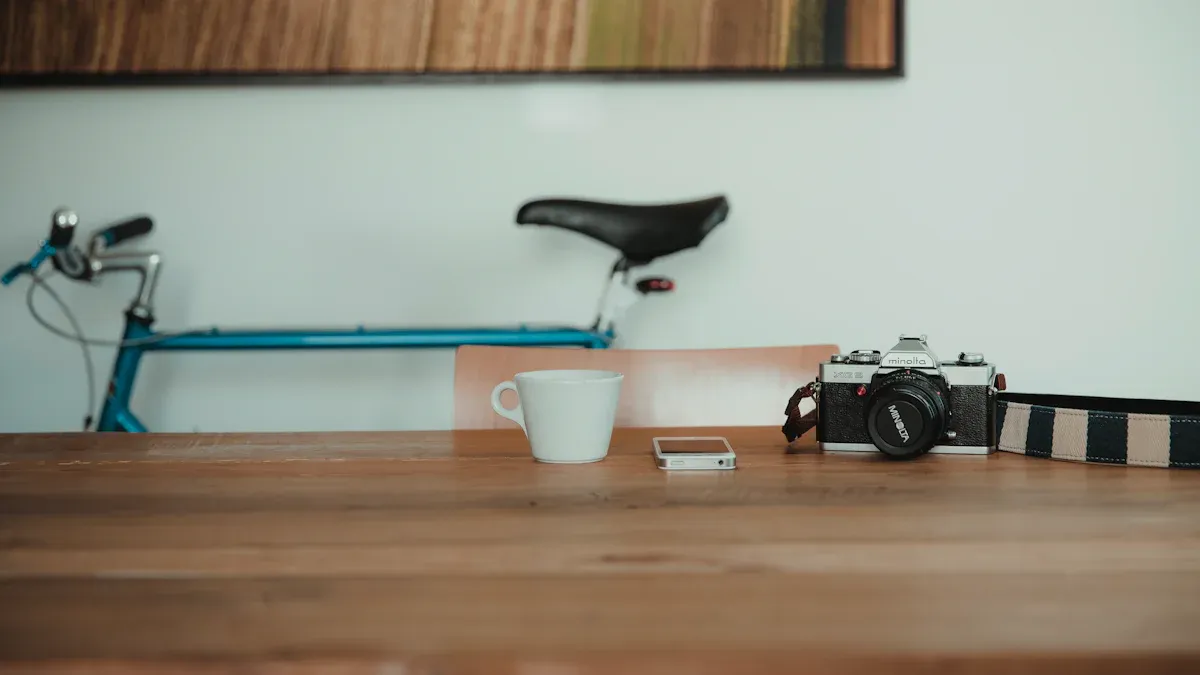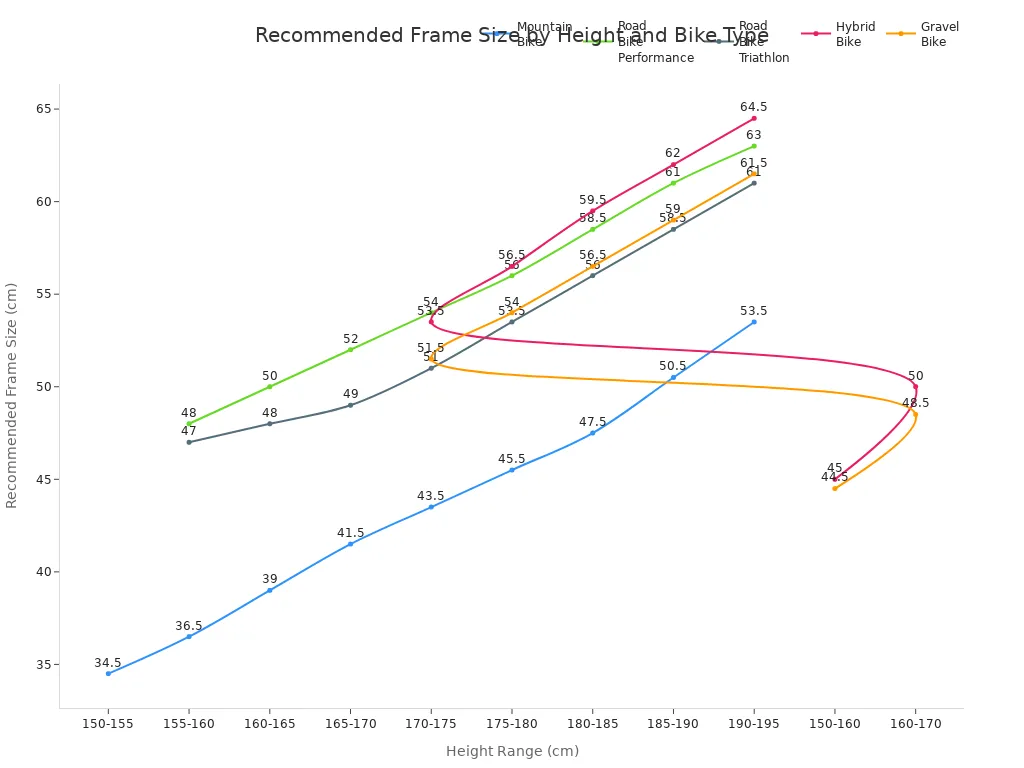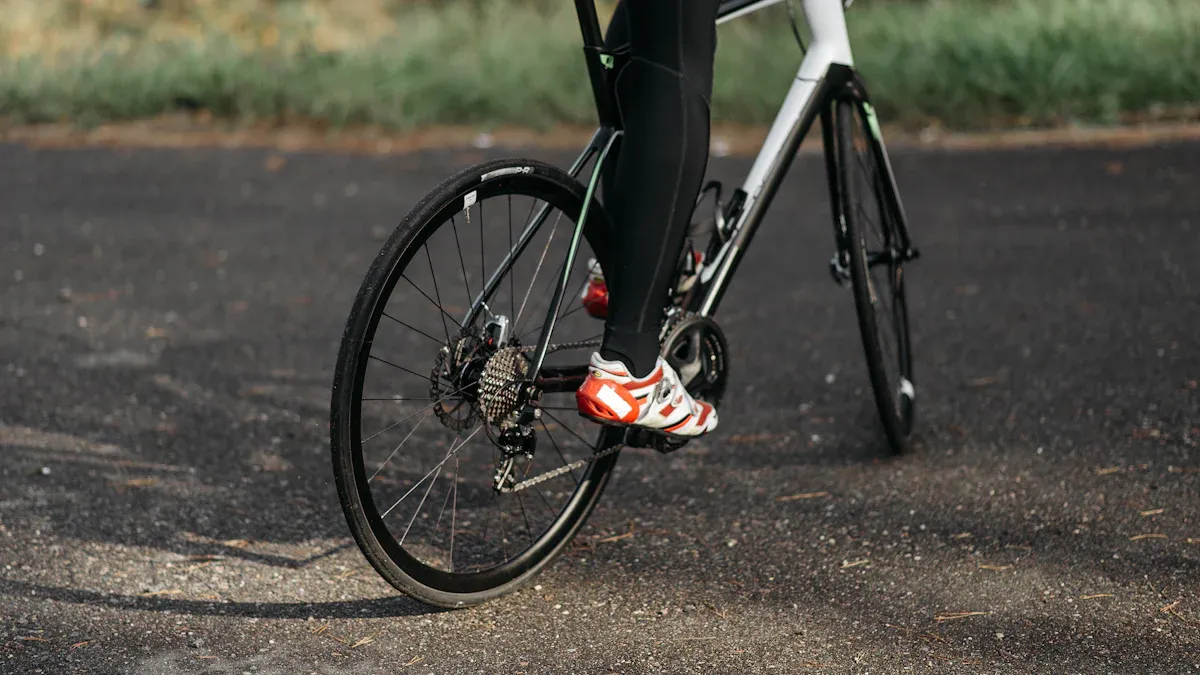
When you determine bike frame size, you need to measure your inseam, height, torso length, arm length, standover height, stack, and reach. These measurements are essential to find a frame size that fits you well, keeps you safe, and improves your riding experience.
Inseam and height are key factors to determine bike frame size, as they correspond to your leg stretch and seat height for smoother pedaling.
Torso length and arm length affect reach and stack, which influence how you sit and fit on the bike.
Standover height ensures you have enough clearance to get on and off the bike safely.
Stack and reach help you find a comfortable position that matches your riding style.
Additionally, consider your gender, riding style, flexibility, and the type of bike you want, as these factors can impact how you determine bike frame size and overall fit.
Key Takeaways
Measure your inseam, height, torso, and arm length. Also check standover height, stack, and reach. This helps you find a bike frame that fits well. It also makes sure you feel comfortable.
Use inseam and height as your main guide for frame size. Adjust for torso and arm length too. This helps you not feel too stretched or cramped.
Make sure you have enough standover clearance. For road bikes, you need 1-2 inches. For mountain bikes, you need 2-3 inches. This keeps you safe and comfortable when getting on or off.
Test ride bikes before you choose one. Make small changes to saddle height, stem length, and handlebar position. This helps improve fit and comfort.
Look at size charts before picking a frame size. Think about your riding style, flexibility, and body shape. This helps you choose the best frame size and avoid common fitting mistakes.
Frame Size Measurements

Inseam & Height
Your inseam and height are the foundation for choosing the right frame size. The inseam measures the distance from the floor to your crotch. This measurement is more precise than height alone because it directly affects how you reach the pedals and the ground. Most bike manufacturers use inseam and height to guide sizing, but inseam gives a better fit for standover height and comfort.
You can use your inseam to calculate frame size for different bike types. For road bikes, multiply your inseam (in centimeters) by 0.70. For mountain bikes, use a multiplier of 0.66. Hybrid bikes use a similar formula to road bikes but offer a more relaxed fit. This approach helps match your body to the bike’s geometry and ensures you have the right standover clearance.
Here is a table that shows how inseam and height relate to recommended frame sizes for different bike types:
Height Range (ft/in) | Inseam Length (in) | Road Bike Frame Size (cm) | Mountain Bike Frame Size (in) | Hybrid/Electric Bike Frame Size (cm) |
|---|---|---|---|---|
4’10” – 5’2″ | 25 – 27 | 47 – 49 | 13 – 14 | 47 – 49 |
5’3″ – 5’6″ | 27 – 29 | 50 – 52 | 15 – 16 | 50 – 52 |
5’7″ – 5’9″ | 29 – 31 | 53 – 55 | 17 – 18 | 53 – 55 |
5’10” – 6’0″ | 31 – 33 | 56 – 58 | 19 – 20 | 56 – 58 |
6’1″ – 6’4″ | 33 – 35 | 60 – 62 | 21 – 22 | 60 – 62 |
Tip: Always measure your inseam with your shoes off and stand straight for the most accurate result.
You can also see how recommended frame size increases with height in this chart:

Torso & Arm Length
Torso and arm length help fine-tune your fit, especially for reach and comfort. To measure your torso, place a tape measure at your crotch and extend it up to your sternum. For arm length, measure from your armpit to the tip of your middle finger. These measurements help you find a frame size that matches your upper body and prevents you from feeling too stretched or cramped.
Bike fitters often combine torso and arm length with inseam to recommend the best frame size and adjust components like the stem or handlebars. If you have a longer torso or arms, you may need a frame with a longer reach or a different stem length. This ensures you can ride comfortably and maintain good posture.
Note: If you feel discomfort in your shoulders or back, your reach may not match your torso and arm length. Adjusting the stem or handlebar position can help.
Standover Height
Standover height is the distance from the ground to the top tube of the bike frame. This measurement is crucial for safety and comfort. You need enough standover clearance to stand over the bike with both feet flat on the ground. For road and hybrid bikes, aim for 1-2 inches of clearance. For mountain bikes, 2-3 inches is best because you need more room for rough terrain.
Rider Comfort | Safety Level | Performance Impact | |
|---|---|---|---|
1-2 inches (road/hybrid) | High | High | Optimal control |
2-3 inches (mountain) | High | High | Optimal control |
Less than 1 inch | Moderate | Moderate risk | Possible discomfort |
No clearance | Low | High risk injury | Reduced maneuverability |
If your standover height is too tight, you risk injury when mounting or dismounting. Too little clearance can also cause discomfort and reduce your control of the bike. Many modern mountain bikes have lower standover heights to make it easier to get on and off the bike.
🚨 Incorrect standover height can lead to knee pain, back pain, or even falls. Always check your standover clearance before choosing a frame size.
Stack & Reach
Stack and reach are technical measurements that define your position on the bike. Stack is the vertical distance from the bottom bracket to the top of the head tube. Reach is the horizontal distance from the bottom bracket to the center of the head tube. These measurements shape your posture and affect how the bike handles.
A higher stack with a shorter reach gives you a more upright and relaxed position. This setup is great for endurance rides or if you want comfort. A lower stack with a longer reach puts you in a more aggressive, aerodynamic position, which is better for racing or fast riding. You can adjust reach slightly by changing the stem length, but only within about 20 mm.
Tip: If you prefer a relaxed ride, look for a frame with a higher stack and shorter reach. For a sportier feel, choose a lower stack and longer reach.
Stack and reach also affect how you control the bike. A longer reach improves stability at high speeds, while a shorter reach makes the bike easier to maneuver. The right balance depends on your riding style and body proportions.
How to Determine Bike Frame Size

Taking Accurate Measurements
You need to take accurate measurements to determine bike frame size. Each body part measurement helps you find a bike that fits you well and keeps you comfortable. Follow these steps to measure yourself correctly:
Inseam: Stand with your back against a wall. Place a book between your legs, pressing it up to your crotch. Measure from the floor to the top of the book. Take this measurement with your shoes off for the best results.
Height: Stand straight against a wall. Use a flat object like a ruler on your head and mark the wall. Measure from the floor to the mark.
Torso Length: Sit on a hard surface. Measure from your crotch to the top of your sternum (the bone between your chest).
Arm Length: Stretch your arm out to the side. Measure from your armpit to the tip of your middle finger.
Standover Height: Wear your cycling shoes. Stand over the bike frame. Measure the distance from the top tube to your crotch. You should have at least 1-2 inches of clearance for road bikes and 2-3 inches for mountain bikes.
Stack and Reach: These are frame measurements, not body measurements. Check the bike’s geometry chart for stack (vertical distance from the bottom bracket to the top of the head tube) and reach (horizontal distance from the bottom bracket to the head tube).
Tip: Use a tape measure for all measurements. Ask a friend to help for more accuracy.
For even more precise results, you can use digital video tools. Many bike fitters use high frame-rate cameras like GoPro or smartphones with 120 fps. Place the camera at hip height and keep it perpendicular to your body. Good lighting helps the camera capture clear images. Some people film the lower and upper body separately to get closer shots of joints. You can use free software like Kinovea to analyze your position. This method helps you see your posture and joint angles, making it easier to determine bike frame size and improve your fit.
Common Mistakes
Many people make errors when they try to determine bike frame size. These mistakes can lead to discomfort, poor performance, or even injury. Here are some of the most common mistakes and how you can avoid them:
Common Error | Explanation | How to Avoid |
|---|---|---|
Starting with the wrong frame size | Picking a frame that does not match your body can hurt comfort and handling. | Consult a professional fitter before you buy. Make sure the frame size matches your body. |
Changing equipment without adjusting fit | Swapping saddles, handlebars, or stems can change your fit by up to 1.5 cm. | Adjust your fit every time you change a component, especially saddle height and reach. |
Getting fitted on only one bike | Each bike type has different geometry. One fit does not work for all bikes. | Get a fit for every bike you ride to stay comfortable and safe. |
Assuming a fit done indoors applies outdoors | Indoor fitting does not show how you move or ride outside. | Ride naturally during fitting. Let your effort and movement guide adjustments. |
Relying solely on fitter certification | Certification does not always mean experience or skill. | Ask your fitter about their experience and approach to fitting. |
Using outdated fitting methods | Old methods may not work with modern bikes. | Choose a fitter who knows about current bike designs and fitting techniques. |
🚨 Always double-check your measurements and your fit after any changes. A small mistake can make a big difference in comfort and safety.
When you determine bike frame size, take your time and use the right tools. Accurate measurements help you find a bike that fits you perfectly. Avoid common mistakes to enjoy a better ride and reduce the risk of injury. If you feel unsure, ask a professional to help you determine bike frame size and check your fit.
Bike Geometry & Sizing
Frame Geometry Basics
It is important to know how your body size matches the bike frame. The seat tube length usually fits your inseam. Many new bikes have sloping top tubes, so the top tube length matters more. If your legs are longer than your torso, you need to look at the top tube length for comfort. The seat tube angle is between 71 and 75 degrees. This angle changes where your saddle sits. It also affects how you pedal and how well you ride. The effective top tube length is the space from the seat tube to the head tube. This helps you match your torso and arm length to the bike. It gives you the right posture and reach. You can change stem length and saddle setback to make your fit better. Always check that your inseam, torso, and arm length work with the bike frame for the best ride.
Using Size Charts
Size charts help you find the right bike frame for your body. Most brands give charts with frame sizes based on height and inseam. Some also use arm or torso length. Road bikes use centimeters for frame size. Mountain bikes use inches or letters. Different brands may give different sizes for the same measurements. Some brands say to pick a bigger size if you have long arms or want more stretch. Others say to pick a smaller size for better control, especially for mountain bikes. Use size charts to start, but always check reach and stack. Test rides and getting fitted by a pro help you find the best size.
📝 Tip: Do not trust size labels alone. Always look at the geometry chart for reach, stack, and top tube length.
Brand & Bike Type Differences
Bike sizing rules change with the type and brand. Road bikes use centimeters for frame size and focus on seat tube length. Mountain bikes use letters or inches. Some brands have many sizes for the same height. Kids’ bikes use wheel size instead of frame size. For example:
Adult bikes use frame size linked to rider height.
Road bikes measure frame size in centimeters.
Mountain bikes use height or letter sizes.
Brands make bikes for different uses. Some bikes have tight geometry for speed. Others have longer wheelbases and relaxed angles for stability. For example, a road bike like the Alpe d’Huez has a short wheelbase and tight angles for climbing and speed. Gravel bikes like the ADHX 45 have longer wheelbases and relaxed angles for rough ground. The material and tire size also change frame geometry and how the bike handles. Always check the brand’s size chart and geometry before you pick a frame.
Bike Model | Tire Size | Geometry Features | Use Case |
|---|---|---|---|
Alpe d’Huez (ADH) | 700x28c | Short wheelbase, tight angles | Road, climbing, speed |
ADHX | 700x38c | Longer wheelbase, slacker angles | All-road, mixed surfaces |
ADHX 45 Gravel | 700x45c | Long wheelbase, relaxed angles | Gravel, rough terrain |
🚲 Note: Always compare size charts from the same brand. Labels like “Medium” or “56cm” can fit differently with each brand.
Bike Fit Factors
Gender & Body Proportions
Your gender and body shape help you find the right bike size. Women’s bikes often have shorter top tubes and sloping frames. This matches shorter torsos and longer legs. Men’s bikes usually have longer top tubes for longer torsos. Handlebars and saddles are different for men and women. They fit shoulder width and pelvic shape. Here is a table that shows the main differences:
Aspect | Women’s Bikes | Men’s Bikes |
|---|---|---|
Frame Geometry | Shorter top tubes, sloping frames | Longer top tubes, straighter frames |
Handlebars | Narrower, smaller grips | Wider, larger grips |
Saddles | Wider, shorter | Narrower |
Sizing Focus | Inseam and top tube length | Torso length and reach |
Your body shape matters too. If you have short legs and a long torso, you might feel hunched on a bike that fits your height. You may need a smaller frame and a longer stem. If you have long legs and a short torso, you may need a taller frame and a shorter stem. This helps you sit comfortably and avoid pain.
Body Proportion | Impact on Fit | Recommended Adjustments |
|---|---|---|
Short Legs | Too hunched | Size down, longer stem |
Long Legs | Excessive reach | Size up, shorter stem |
Flexibility & Riding Style
How flexible you are changes your riding position and comfort. If you are flexible, you can ride lower and more aerodynamic. If you are not flexible, you need to sit more upright for comfort. A professional bike fit checks your flexibility and helps you find the best size and position.
Your riding style also affects your bike fit. Race bikes have longer top tubes and lower head tubes. This gives you a more aggressive position. Endurance bikes have shorter top tubes and taller head tubes. This gives you a relaxed position. If you like fast rides, you may want a smaller frame for a lower position. If you want comfort, a bigger frame with higher handlebars works better.
Adjustments & Test Rides
You can change small things on your bike to make it fit better. Adjusting the stem, saddle height, and handlebar position helps you find the best riding position. A longer stem gives you more reach. Raising the saddle helps you get the right bike size. Moving the saddle forward or backward changes your reach and comfort. These changes help you get a fit that works for you.
A test ride is the best way to check your bike fit. Ride on different roads and see how you feel. A professional bike fit uses tools and expert advice to make sure your bike fits well. If you are between sizes, picking the smaller size is usually better. You can raise the saddle and use a longer stem to get the best position. This helps you avoid pain and enjoy your ride.
Tip: Always test ride after you make changes. A professional bike fit can stop pain and help you ride better.
Bicycle Sizing Tips
Comfort & Safety
You should always prioritize comfort on the bike when choosing your frame size. A good fit helps you avoid pain and keeps you safe during every ride. Studies show that the right saddle height and setback can lower your risk of injury and make riding feel easier. If your saddle sits too low, you may feel more tired and put extra strain on your knees. When you set your bike up to match your body, you improve comfort on the bike and reduce the chance of overuse injuries.
🚨 Always check your position before long rides. A small change in saddle height or handlebar reach can make a big difference in overall comfort and safety.
Bicycle sizing also affects how easily you can control your bike. If your frame is too big or too small, you may struggle to stop quickly or balance at slow speeds. You want to stand over your bike with both feet flat and have enough clearance to get on and off safely. Remember, a comfortable bike keeps you riding longer and helps prevent accidents.
Performance Considerations
Correct bicycle sizing does more than keep you comfortable—it boosts your performance. When your bike fits well, you can pedal harder and faster without wasting energy. Professional cyclists and coaches agree that matching frame size to your body shape helps you use your muscles better and ride with more power. You will notice better handling and stability, especially when you ride fast or take sharp turns.
Proper frame size improves aerodynamics by letting you ride in a lower, longer position.
Good sizing helps you steer quickly and control your bike with less effort.
The right saddle height and handlebar position let you transfer power to the pedals efficiently.
If you ride a bike that does not fit, you may feel cramped or awkward. This can slow you down and make you tired faster. Always choose a frame that matches your body and riding style. A professional bike fit can help you find the best setup for both comfort and performance.
Picking the right bike size begins with careful measuring and knowing bike geometry. You feel safer, more comfortable, and ride better when your inseam, standover height, and reach fit the frame. Experts suggest these steps:
Start with size charts to get an idea.
Try out different bikes to see what feels good.
Ask a professional for help with adjustments.
A bike that fits well helps stop pain, gives you better control, and makes riding more fun.
FAQ
How do I know if my bike frame is too big or too small?
You may feel stretched out or cramped when you ride. Your knees might hit the handlebars, or you cannot reach the pedals comfortably. Try standing over the frame. If you lack clearance, the frame is likely too big.
Can I adjust a bike that feels uncomfortable?
You can make small changes to the saddle height, stem length, or handlebar position. These adjustments help improve comfort and fit. If you still feel pain or discomfort, you may need a different frame size.
Do kids need different bike sizing rules?
Kids’ bikes use wheel size instead of frame size. You should check that your child can touch the ground with both feet. Make sure they can reach the handlebars and brakes easily. Safety and control matter most for kids.
What should I do if I am between two frame sizes?
Choose the smaller size. You can raise the saddle or use a longer stem to improve fit. A smaller frame gives you better control and helps prevent injuries. Test ride both sizes if possible.
See Also
Determine Your Ideal Bike Frame Size Using Height And Inseam
Step-By-Step Guide To Measuring Height And Inseam For Bikes
Using A Bike Frame Size Chart To Get Perfect Fit
